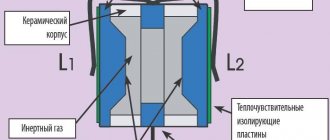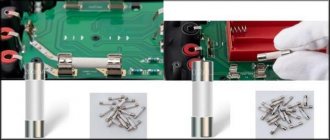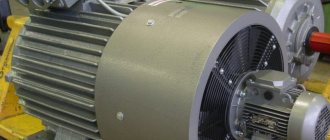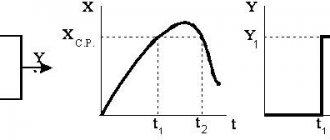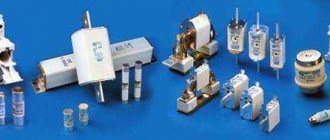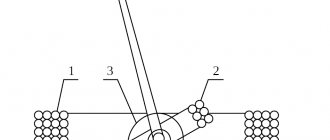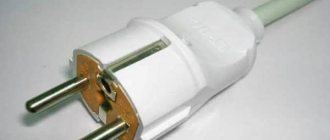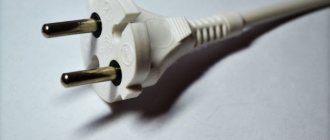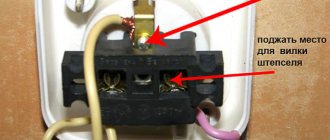Fork designs
They are produced in such a form that it is not possible to use forks:
- with sockets
having a higher voltage rating, or a lower current rating, than those for the plug; - with a different number of current-carrying poles
, with the exception of sockets specially designed for use with plugs having a smaller number of poles, provided that no dangerous situation arises, for example, connecting one of the poles to the grounding contact or interrupting the grounding circuit; - with grounding contact
, if the plug is intended for devices of protection class 0.
Plug Types
in Fig. 2.
Note - Connector is considered unusable
, if new parts or materials are required to reassemble it.
In working sockets there are pins and plugs
must be:
- secured against turning;
- non-removable forks without disassembling;
- suitably secured to the housing
when the supply wires are connected to them as during normal operation.
Note: The possibility of misalignment must be excluded.
ground, neutral and live pins of the plug.
Problems can also occur inside the plug.
. Plugs only work when they are connected to a power outlet. In older homes, socket outlets are designed for split pin plugs.
Covers for dismountable connectors (plugs)
should cover the contact terminals and ends of a flexible cable, cord or wire.
Fork design
must ensure the correct and reliable connection of the wires and, if the wires are connected to the connector and are ready for normal use, the following
must be excluded
:
- wire strands
with each other ; - touching the conductors of wires connected to the contact terminals of accessible metal parts
; - touching the wire core connected to the grounding terminal of live parts
.
Dismountable connectors
must be designed so that the screws or nuts of the terminals do not become loose or fall out of their recesses.
Dismountable connectors
are designed to provide sufficient space to accommodate the grounding wire.
And when it was loosened in the contact clamp, subsequent fastening of the grounding wire
could be done
without disturbing
the connection of
the phase wires
.
Connection between ground pin
(Fig. 3, item 3) of the plug connector must be installed before the current-carrying contacts come into contact
The order of disconnecting the plug connector must be reversed, as a result of which the ground contacts
are performed
longer than the working contacts
.
Ground contact
s, regardless of their number, are considered one pole.
Grounding Plug
for connecting a household
electric cooker
using a single-phase circuit to a 220V electrical network is shown in Fig. 3.
To enable
For portable power tools with voltages higher than 42 V, if grounding is necessary,
the plug connectors
are equipped with a special contact for switching on the grounding conductor. Moreover, their design must exclude the possibility of using current-carrying contacts as contacts intended for grounding.
In addition, in order to distinguish between grounding contacts
(Fig.3 pos.3)
from the workers
(Fig.3 pos.2) a ring is applied to their bases with red paint, the same ring is applied to the socket of the plug socket.
To connect the ground contact
A separate wire strand must be used between the plug and the metal body of the electrical receiver.
Note - To ensure proper cooling of the terminals
For plugs, the wire connected to them must be
at least 1 m
.
The fine line of gradation
Conventionally, all existing electrical equipment according to the method of interfacing with the electrical network can be divided into two categories:
— Stationary, which is connected to the current source with a cable and a permanent connection. Of course, if you have the tools, you can turn it off, but only in emergency situations. An example would be equipment in production.
— Relatively mobile, allowing you to disconnect from the power source without using specialized devices. This group includes almost all household electrical appliances. Their distinctive feature is the plug.
How to find suitable electronics for Joom
The Chinese trading platform often holds large sales, allowing customers to save significantly. Sometimes the discounts reach 90%. You can get various accessories for electronic equipment almost free of charge. For example – chargers, adapters, energy storage devices. Before paying for the goods, be sure to read the product description and technical specifications.
Typically the description contains the maximum voltage at which the electrical device operates. The type of plug (AU or EU Plug) is also indicated. We have discussed in detail the meanings of these terms above. Taking into account this feature, each buyer will be able to protect themselves from unexpected financial expenses for the purchase of a specialized adapter.
What is a plug
Everyone has encountered sockets and power plugs. However, few people understand where the term “plug” comes from. It's actually simple. The word "plug" is of German origin. And it means nothing more than a traffic jam. Indeed, the plug, being in the socket, seems to clog the holes of the latter. Hence the term. Well, the additional word “fork” appeared due to its distant resemblance to the famous cutlery. Of course, the tasks of this device are completely different, although, it is worth recognizing, there are real plastic plugs for sockets on the market that protect curious children from accidental electrical injury.
Story
The Europlug design was developed in 1963 and published in Sheet XVI of standards in the second edition of Publication No. 7 of the International Commission on the Rules for the Approval of Electrical Equipment (CEE). The development was based on most of the standards for power outlets common in Europe. The Euro fork is also called a “CEE 7/16” fork. In 1975 it was also adopted by the International Electrotechnical Commission (IEC) Technical Report 83 as the C5 plug (now IEC/TR 60083), and in July 1990 as the European standard EN 50075.
From theory to practice
In simple terms, what a plug is, is a device designed to provide the ability to make a secure detachable connection to a specially designed socket.
Old-timers remember that previously this type of connection was used even in places where it is now impossible to even imagine such a thing. Thus, during the Soviet five-year plans, special lamp designs were used everywhere in lighting networks, which made it possible, through simple manipulation without tools, to disconnect the block with the socket and lamp, leaving on the line... a plug socket. True, its design was somewhat different from the solutions familiar to the modern eye. Now, of course, they try to separate cable routes as much as possible, so lighting circuits, as a rule, do not allow the transmission of significant powers.
Ali plug types
In order to ensure that after purchasing a kettle it can be connected to the network in Russia without additional manipulations, you need to indicate the correct type when placing an order. Here it is worth referring to the standards for designating voltage plugs. As of 2022, the world still has not come to a single plug, since electrical networks in all countries have different voltages. For Russia, 220 Volts and 50 Hz are typical.
This is all theory; in practice, the buyer receives different types of forks:
UK
AU
EU
US
There are several markings of the plug for electrical appliances on aliexpress:
- UK - standard socket plug for the UK and some other countries. It has 3 pins placed in different planes.
- AU - plug for China, Singapore and Australia. 2 flat pins are located in an inclined plane relative to each other.
- EU plug is a type of plug from Aliexpress suitable for Russia. The plug is called European. Also, electrical appliances with such an outlet work in Belarus, Turkey and other countries of the former USSR.
- US - plug for electrical networks in the USA, Japan and South Korea. It has 2 flat pins located parallel to each other.
Let us note once again - of the listed types of plugs for sockets from Aliexpress, only EU is suitable for Russia . Select it when completing the product.
What do these markings mean and which plug to choose for Russia?
In fact, the variety of connectors is quite large. But on Aliexpress there are 4 most common types of plugs:
- AU plug - this type of plug is used in Australia, China and Argentina. Has 2 vertical plugs inclined towards each other.
- EU plug - or simply, “Euro plug”, “Euro socket”. This is the type of connector familiar to us. This type of plug is suitable for Russia, CIS countries, continental European countries and many other countries.
- UK plug - an English type of socket with three flat pins, two of which are located horizontally and one vertically. Used in the UK, Ireland, Malta, Malaysia, Singapore.
- US plug - American standard with two vertical pins. Distributed in the USA, Mexico, Canada and Japan.
I accidentally bought a product with a different plug, what should I do?
If you make a mistake when purchasing a product and choose a plug that does not fit our sockets, do not be upset. There's nothing scary. This problem can be easily resolved by purchasing an adapter for the required connector. These are sold in stores, there is no shortage of them.
Note! The adapter does not reduce the voltage or increase it. It will just allow you to connect the plug to the required type of socket.
If desired, if you want to eliminate the intermediate element, you can buy the usual collapsible Russian plug and completely replace it.
Products with Chinese plugs
Quite often on Aliexpress, new products that have just appeared on sale are sold only with Chinese plugs. Therefore, even if you want, you will not be able to buy a product with the plug you need.
The seller, of course, can include an EU plug adapter with the product, but you should pay attention to it. If the adapter pins are thin enough and are not fully inserted into the socket or the plug “dangles” in the socket, then in order to avoid problems associated with poor contact (burnout of the plug-socket), it should be replaced.
Plug device
There are several options for the design of this detachable connection element. Thus, there are special solutions designed for connecting fairly powerful electrical equipment to a three-phase network - they use four contacts (three for phases and a grounding one). However, in mass production, a simpler design is used - exactly the same as, for example, a table lamp plug.
Externally, these are two metal (copper or chrome-plated) rods, placed parallel at a certain distance from each other and located in a housing made of dielectric material. Inside each of them there is a bolt or other clamp designed for connecting current-carrying conductors and grounding. Through such a system, electricity is supplied to the device via a cord (cable). The housing can be dismountable, in which case its parts are assembled together using a screw. There are also monolithic modifications. The thickness of the rods and the method of making the grounding contact are determined by standards. So, speaking about what a plug is, one cannot help but point out a common misconception in the countries of the former USSR, according to which there are two types of power plugs (and sockets) - regular and euro.
A Brief History of Electrical Plugs
The kit used to connect household appliances to the electrical network is called a “plug connector”. It includes:
- socket - a connector in the form of a socket to which electricity is supplied;
- plug - a device fixedly installed or connected to the device using a cable for connecting to the electrical network.
Harvey Hubbell
A patent for a socket-and-plug connection was received by Harvey Hubbell in 1904. Introducing a new type of connection, he intended to replace the unsafe connection of electrical appliances using lamp sockets (Edison's method). By about 1920, Hubbell's method began to be adopted everywhere. The invention of the Schutzkontakt system (Schuko) by Albert Büttner in 1926, a set consisting of a socket and a power plug grounded using bracket-shaped contacts, helped to finally establish itself as a safe and simple means of delivering electricity to household appliances.
The introduction of innovations in different countries in the 20th century went in parallel with the development and approval of electrical network standards. They include two main parameters:
- voltage (unit of measurement – Volt);
- frequency (unit - Hertz).
Interestingly, one country can use one or several standards. Some countries have decided to harmonize standards. Today there are at least twelve of them.
Variety of modifications
The term “euro” is used in relation to the CEE 7/4 standard (Type F, or Shuko) - these are fairly large products that necessarily contain a grounding contact or rod in the design. The socket holes are deepened in such a way that when the plug is turned on, it is impossible to accidentally touch the half-extracted rods of the plug. The plug-in connection using CEE 7/4 is designed for 16 A and 230 V. The name “euro” was given due to the fact that in Soviet times, devices from the GDR and Czechoslovakia were supplied with exactly such plugs.
In fact, the Euro fork does exist. This is a solution based on the CEE 7/16 standard. Those who have ever wondered what the structure of a table lamp plug is, knows all the features of this type of design. For others, let us explain: a Europlug consists of two rods with a thickness similar to Soviet (ordinary) plugs, located in a thin monolithic body made of dense rubber. There is no grounding contact. The shape is such that such a plug can be easily inserted into a socket of almost any design. Safety from accidental contact is achieved by insulating most of the rods, leaving only the outer parts, about 5 mm long, exposed. These Euro plugs are designed for connecting low-power equipment, such as table lamps. The permissible current is 2.5A, although there are modifications for 5A.
How are plug connections classified?
So, the main reason for using different types of electrical plugs in different countries is the electrical network standard established by the state.
Country map: types of sockets and plugs
Type A and B (American)
American Socket and Plug
There are two types of electrical sockets used in the United States: Type A and Type B. Type A is two-prong, Type B is three-prong. Both types operate under a voltage of 120 V with a frequency of 60 Hz. Nema 5-15R type plug connectors are provided for these sockets.
The design of the Type A plug secures the plug firmly in the socket: the neutral contact is wider than the phase contact. Type A plugs can be used for both types of socket designs. In the past, they were provided on devices that did not require grounding. In modern homes, sockets of this type are not used because they are not safe.
The Type B plug has a flat, long grounding pin, which eliminates the possibility of inserting the plug incorrectly into the socket. If an electrical appliance fails, this design of the socket eliminates the possibility of electric shock in the event of a leak: the grounding will work before the consumer comes into contact with the current.
Type D (Asian)
Type D plug and socket
The type D plug, the so-called “Asian” type, is designed with three round contacts arranged in the shape of a triangle. Type D sockets are defined by the old British standard BS 546, which was in force in developed countries until 1962. Type D plugs are found in countries that were former British colonies, where representatives of Great Britain were involved in electrification. The socket provides grounding and is designed for a current of up to 5 A, operating at a voltage of 220-240 V.
Interesting: Why does it give me an electric shock? Explanation, photos and videos
Used in Asian countries. However, over time, this type was considered obsolete, and it was taken out of use by replacement with later versions rated at 15 A. Connectors of this type can still be found in Sri Lanka, Burma and India, Bangladesh and Namibia. It is used primarily in developing countries and, according to various sources, accounts for about 15% of the use of other types of sockets in these same countries.
Type G (British)
Socket and plug in the UK
The Type G plug is defined by the British standard BS 1363, which was introduced immediately after the Second World War in 1946. It is quite large in size. The design consists of three large polarized contacts and a fuse hidden inside. The polar contacts are flat, rectangular in shape, and covered with insulation at their base.
The fuse protects the power wire that carries current to the devices. This is justified by the nature of the wiring used in the UK. The sockets are designed for a voltage of 220-240 V and a standard frequency of 50 Hz. The current strength is allowed up to 13 A.
Plug connectors of this type are designed to have protective shutters that open when the grounding contact is connected. Even if the device does not provide grounding, there is a plastic imitation in its place.
The history of the emergence of British type sockets is associated with a copper shortage in the period from 1941 to 1945. The structure of the connectors made it possible to save scarce metal. The presence of a built-in fuse explains the large size of the plug. The UK electrical network allows for high current levels, so earthing is required to ensure safety. Sockets of this type are used in the UK, Ireland, Singapore, and Cyprus.
Type I (Australian)
Australian Electrical Socket and
Plug Type I plugs are otherwise called Australian electrical sockets and plugs because they are used primarily in Australia and New Zealand. The socket is designed for voltage up to 240 V and current up to 10 A, which is less safe for humans, compared, for example, with American sockets, but is easier to implement technically. The Australian standard has undergone significant changes over time: since 1937 - C112, since 1990 - AS 3112, since 2015 - AS/NZS 3112:2004.
According to the latest changes to the standard, the design of a Type I plug consists of 2 flat pole blade contacts with insulation, located at a distance of 1.37 cm from each other at an angle of 30 degrees to the vertical, a house, and a grounding pin. 90% of these sockets have a switch for additional safety for humans. There are also plugs with a wider grounding blade that handle amperages up to 15, 20, 25, and 32 A. The 20, 25, and 32 Amp plugs have a special design that is not compatible with the lower amperage plug.
Type H (Israeli)
Two Israeli plugs and one socket.
On the left is the old standard fork, on the right is the modernization of 1989. Type H plugs are called Israeli plugs. Mains voltage up to 230 V at a frequency of 50 Hz. The sockets are designed for current up to 16 A. They are used exclusively in Israel and disputed territories. Regulated by Israeli standard SI 32 (IS16A-R).
Interesting: Why do high-voltage wires hum? Reasons, photos and videos
Initially, the plug consisted of three flat contacts: neutral, phase and ground - located at an angle of 45 degrees, in the shape of a triangle or the letter Y. The distance between the polar, phase and neutral, flat pins was 1.9 cm.
Over time, practice has shown that during active use of equipment with high power consumption, the flat contacts overheat, which is unsafe. So, in 1989, changes were made to the standard: flat pins were replaced with round pins with a radius of 2 mm. Although Israeli-type sockets are three-pin and unique in this country, the connector fits two-pin Type C plugs - Euro plugs, as well as older model Type H plugs - with flat contacts.
Type K (Danish)
Danish plug and socket
Danish type K plugs are used mainly in Denmark and Greenland, and are partially present in Bangladesh and Madagascar, Guinea, Senegal and the Faroe Islands, that is, only 2.8% of 246 countries. Visually, the Danish connector resembles a smiling emoticon. The plug consists of two round feed pins located on a round base 1.9 cm apart. A semicircular grounding prong is also found on the plug and fits into a special socket on the receptacle.
The connectors, according to the design, are polarized, that is, a wire with potential - a phase - of a special shape. However, there is no universal standard for connecting phase and neutral wires. Most outlets are equipped with a switch for safety when plugging or unplugging.
The socket and plug are specified by the Danish standard SRAF1962/DB 16/87 DN10A-R. Since 2008, it is mandatory to have grounding and a residual current device (HFI). Designed to operate under voltages up to 250 V, with a current of up to 10 A and a frequency of 50 Hz.
The K-type socket is a product of the Danish monopoly company Lauritz Knudsen. Thus, in order to expand the electrical equipment market, the country also uses E-type sockets - with two contacts and a French-type grounding socket.
Type C and F (European)
European socket type C and F.
Plug type C and F are widely used all over the world, especially in the Russian Federation and former USSR countries. Plugs of different standards fit into type C plug connectors. C plugs in most cases fit into F sockets and vice versa, but there are significant differences between them.
Europlug type C (Europlug) consists of two round pins with a radius of 2-2.4 mm. The pins are spaced 19mm apart. The connector, accordingly, has round holes. Grounding is not provided here. The socket is designed for a voltage of up to 250 V at a frequency of up to 50 Hz and a current of up to 2.5 A. In the technical literature you can find the name CEE 7/16.
The Type C plug is considered obsolete in the modern world because it does not have a ground connection, but it is used almost everywhere in the world. The most relevant option for the current needs of mankind is the F type plug.
The F type socket is designed for high current - up to 16 A, operates under voltage in the range of 220-240 V, with a frequency of up to 50 Hz. Designated in international documentation as CEE 7/4. This type of plug connector is also known as “Schuco” (from the German “schutzkontakt” - protective contact). The standard was patented by German inventor Albert Büttner in 1926 and featured a grounding pin for household appliances.
Interesting: Why are high-voltage wires not insulated? Reasons, photos and videos
Type J (Swiss)
Type J plugs and
sockets Swiss Type J connectors and plugs are regulated by the SEV 1011 standard (ASE1011/1959 SW10A-R). Used in Switzerland and Liechtenstein. The Swiss plug is almost identical in design to the Euro plug (type C) and is compatible with it. The difference is that the J-type plug has a round grounding pin that is installed offset. There are plugs without grounding; they are designed for a current of up to 10 A. For a current of 16 A, a plug with a grounding contact and square-shaped pole pins is provided.
The Swiss plug is not completely harmless when used in everyday life, since the pole pins do not have insulation at the point of attachment to the base, which means that if the plug is not securely fixed in the socket, the possibility of electric shock cannot be ruled out.
Connectors are made internal and external. The internal connector has a separate plug structure located in a box inside the wall. The external connector is wall-mounted in a single-piece housing. J-type plugs come in different types: those with wedge ends are suitable for both external and internal connectors, the other type of pins are only for external ones. Sockets operate under voltage up to 230-250 V, with a power frequency of up to 50 Hz.
Type L (Italian)
Type L plugs 16 A (left) and 10 A (right)
Type L plugs are called Italian because they are used in Italy and Chile. The Italian standard CEI 23-16/VII requires two types of sockets designed for different currents - 10 and 15 A. The variety of models is determined historically: until 1974, electricity was sold for different purposes at different tariffs. Thus, the houses have double meters and double wiring.
Both types of sockets provide grounding. The plug consists of three contacts located on the same line. The pins, with a radius of 2.5 mm, are located at a distance of 26 mm from each other, in the center - between the pole pins - there is a grounding pin.
The 10 A and 15 A plugs differ only in size, the 15 A plug is larger. The socket connectors are made universal for both models. They are also suitable for type C plugs. The sockets are designed for voltage 220-240 V. The design does not provide a fuse. Sockets can be installed both horizontally and vertically.
An interesting fact is that L-type sockets are sometimes called industrial sockets domestically, although they have never been used in production.
Since Italy is integrated into the European Union, universal sockets are currently popular, which are suitable for both classic Italian plugs and the common Europlug and Schuko plugs.
Residents of Russia and the CIS countries, where a single standard is used, will not have to adapt to new plugs and sockets when arriving in most European countries, the African Mediterranean, India, China, Turkey and Thailand. By carefully studying the map indicating which countries use which standards and plug connections, travelers will save themselves from additional problems and costs.
Maintainability
The design of the table lamp plug used in mass production does not allow for acceptable repairs in the event of damage. Although such monolithic plugs can be cut and the internal contacts restored by soldering, after such an operation it is impossible to ensure electrical safety while maintaining normal appearance. This applies to all monolithic solutions. If they are damaged, the power cable is cut as close to the plug as possible, stripped, the grounding conductor is identified and connected to a new collapsible plug.
